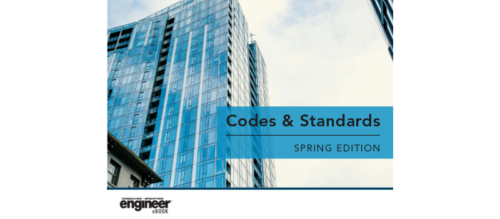Use the right resources to specify LEDs
The Illuminating Engineering Society, through its publications, has helped engineers make informed decisions on which LED light sources they should specify.
An LED luminaire manufacturer had specifications for a roadway LED luminaire claiming a 100,000-h life, 90+ color rendering index (CRI), 100+ lumens/W, and great performance for the distribution of light. A city engineer stated these specifications in a public newspaper, announcing a decision to purchase these luminaires for new roadways. Did the engineer make an informed decision to specify this LED luminaire? Was there a way the engineer could have verified the specifications were legitimate?
Light-emitting diodes (LEDs) are transforming the lighting industry. LEDs are being installed where previous light sources such as halogen lamps, compact fluorescent lights (CFLs), linear fluorescent lamps, and high-intensity discharge (HID) lamps were the industry standards.
Engineers often compare specifications between manufacturers’ products, and in many instances, the luminaires with the stated highest specifications end up in the engineer’s lighting fixture schedule. How does an engineer know if a manufacturer’s LED luminaire meets its specifications?
Supporting documentation
The Illuminating Engineering Society (IES) is a nonprofit society recognized as a reference on the science and application of lighting. The IES is a joint sponsor of ASHRAE/IES Standard 90.1 and Standard 189. The society collaborates on many other lighting, energy, and related documents.
The IES has several documents on LED performance that help engineers separate fact from possible fiction. One document, LUMENS-79-08 Electrical and Photometric Measurements of Solid-State Lighting Products, is a guide that describes the procedures to be followed in measuring a complete LED luminaire’s performance. This guide covers methods for testing measurements such as lumens, luminous efficacy (lumens/W), luminous intensity (candelas) in one or more directions, correlated color temperature, and CRI. The guide covers luminaires and does not cover LED chips, LED packages, and LED modules.
LUMENS-79-08 specifies the test conditions and parameters (e.g., ambient temperature) for measuring an LED-based product’s lighting data. The guide also mandates a test report be generated for each LED product with pertinent data such as the name of the testing agency, the date of the test, and the lighting performance data. A statement of uncertainties is required if applicable.
The efficacy of a light source is the lumens (amount of light generated) per Watt (amount of energy consumed). The efficacy of LEDs has increased over the past few years with efficacy ranges from 50 to 130 lumens/W. LEDs with cool white color temperatures generally have higher efficacies than warm white LEDs.
For comparison, a typical incandescent lamp’s efficacy is 15 lumens/W, a CFL’s efficacy is 60 lumens/W, the best linear fluorescent lamp’s efficacy is 100 lumens/W, and a high-end metal halide lamp’s is 100 lumens/W. (See the 2011 Dept. of Energy Solid-State Lighting Multi-Year Program Plan for more information.)
The efficacy of LED light sources has increased dramatically in a few short years. Expect 100+ lumens/W LEDs to be common in the near future. In the lab, manufacturers recently have produced LEDs that achieved more than 200 lumens/W.
Lifecycle
LEDs can last a long time and, like all light sources, the light output of LEDs declines over time. Unlike other light sources, however, LEDs tend to continuously dim over time rather than burning out. Burning out of a light source is known as a catastrophic failure. LED light sources do not have a filament to “burn out,” so sudden failures are much less common than with other light sources.
Heat, power that is not “clean,” and moisture are factors that contribute to an LED’s demise. How a particular LED deals with these factors determines how long the LED will last.
The IES has another guide, LUMENS-80-08 Measuring Lumen Maintenance of LED Light Sources, that establishes uniform test methods to help determine how long it takes before an LED light source dims to an unacceptable level. LUMENS-80 is for the LED source or module/array itself.
The life of an LED can be measured by the number of hours it takes for the lumen output to fall below a certain threshold; this is known as "lumen maintenance." It happens when the lumen output of the LED light source has depreciated to a percentage of its initial lumens. The rated lumen maintenance life as specified in the LUMENS-80-08 guide refers to two industry recognized periods: the first is the time to 70% lumen maintenance (L70) and the other is 50% lumen maintenance (L50). The lighting industry recognizes L70 as the basis for the useful life of an LED light source for general lighting. The L50 metric is for LEDs used for decorative lighting. These L70 and L50 recommendations come from the Alliance for Solid State Illumination Systems and Technologies (ASSIST), a group led by the Lighting Research Center (LRC).
For example, an LED luminaire with IES LUMENS-80-08 testing and a specified 30,000-h life at 70% lumen maintenance claims the tested LED samples reached 30,000 h before the lumen output fell below 70% of the initial lumen output of the LED light source.
The LUMENS-80-08 guide specifies the test conditions and parameters for measuring the lumen maintenance of LEDs. A test report is required listing key data including how the LED light source was tested.
A typical incandescent lamp has a life of about 1,000 h; CFLs last about 8,000 to 10,000 h; the best linear fluorescent lamps last about 30,000 h. Typical pulse start metal halide lamps have an average lamp life of 7,500 to 20,000 h with lumen maintenance of 50%. Typical LED light sources have an L70 life of 30,000 to 50,000+ h. (See the Dept. of Energy’s “Lifetime of White LEDs” for more details.)
It is important to note that LUMENS-80-08 does not provide a method for estimating the life of an LED light source. IES technical memorandum, TM-21-11 Projecting Long Term Lumen Maintenance of LED Light Sources, “recommends a method for projecting the lumen maintenance of LED light sources from the data obtained by the procedures found in IES document LUMENS-80-08.” This memorandum is used to estimate LED lumen maintenance and service life beyond 6,000 h (the time period required for testing). IES LUMENS-80 specifies testing at three ambient temperatures. TM-21 can be applied for estimating lumen maintenance beyond the test data for all three temperatures (Figure 1).
Verification and testing
Engineers should verify that a manufacturer’s LED light source has been tested according to IES guidelines LUMENS-79-08 and LUMENS-80-08. Estimates of lumen maintenance using IES TM-21 should be provided by the manufacturer. Ideally, the tests should be performed by independent and reputable third-party laboratories.
Engineers should require LED manufacturers to provide IES LUMENS-79-08 and LUMENS-80-08 data and test reports for evaluation. The data should match the published specifications for the LED light source. Engineers also should evaluate the warranty period for LEDs as well as the reputation and history of the manufacturer.
Keep in mind that for a new product, LUMENS-80 testing may be in process; and the report may not be available as it takes more than 8 months to complete the 6,000 h of minimum testing.
Chow is the founder and owner of Metro CD Engineering. He received a BSEE from Ohio Northern University. Chow is a member of the Consulting-Specifying Engineer editorial advisory board.
Resources
Other useful Illuminating Engineering Society publications relating to LEDs include:
- DG-10-12 Design Guide for Choosing Light Sources for General Lighting
- G-2-10 Guideline for the Application of General Illumination ("White") Light-Emitting Diode (LED) Technologies
- TM-16-05 Technical Memorandum on Light Emitting Diode (LED) Sources and Systems
- LUMENS-82-12 Characterization of LED Light Engines and LED Lamps for Electrical and Photometric Properties as a Function of Temperature
Additional resources:
Do you have experience and expertise with the topics mentioned in this content? You should consider contributing to our CFE Media editorial team and getting the recognition you and your company deserve. Click here to start this process.



